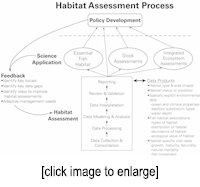What Is a Habitat Assessment?
A habitat assessment is both the process and the products associated with consolidating, analyzing, and reporting the best available information on habitat characteristics relative to the population dynamics of fishery species and other living marine resources. The ultimate goal of a habitat assessment is to determine the function of habitats in relation to fishery production and ecosystems, thereby supporting the management decisions.
In a habitat assessment, spatial and temporal relationships of environmental data (e.g. ocean and climate properties, seafloor substratum types, water depth) with species by life stage are used to determine types, distribution, and amount of habitats that support fishery stocks. Evaluating the function of these habitats ultimately can include measures of habitat-specific vital rates such as growth, maturity, fecundity, and mortality, as well as patterns and rates of species movement among habitats. Data products that may result from a habitat assessment may include: habitat maps; information on habitat status or condition; spatially-explicit environmental data; information on fish-habitat associations; and habitat-specific vital rates.
Habitat Assessment Improvement Plan (HAIP)
The Marine Fisheries Habitat Assessment Improvement Plan (HAIP) was published in May 2010 and is the first nationally coordinated plan to focus on the marine fisheries aspects of habitat science. It outlines current gaps in NOAA Fisheries' habitat science, steps to improve habitat assessments, and the need for a nationally-coordinated habitat science program. The HAIP addresses the current lack of knowledge regarding the association of marine species and their habitats, which impedes effective fisheries and habitat management, protection, restoration, and stock assessment. The document is intended to serve as a blueprint for NOAA Fisheries for coordinating its diverse habitat research, improving habitat assessments, and guiding efforts to increase support for habitat science. With full support and implementation, the HAIP will:
- Develop the habitat science necessary to meet the mandates of the Magnuson-Stevens Act and the economic, social, and environmental needs of the nation
- Improve NOAA Fisheries' ability to identify essential fish habitat and habitat areas of particular concern and assess the impacts to these areas
- Reduce habitat-related uncertainty in stock assessments and facilitate a greater number of advanced stock assessments, including those that explicitly incorporate ecosystem considerations and spatial analyses
- Contribute to assessments of ecosystem services (i.e. the things people need and care about that are provided by marine systems)
- Enable NOAA Fisheries to be prepared for management challenges associated with climate change
- Contribute to ecosystem-based fishery management, integrated ecosystem assessments, and coastal and marine spatial planning




